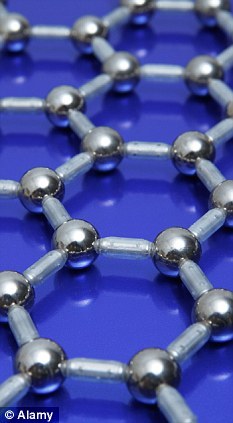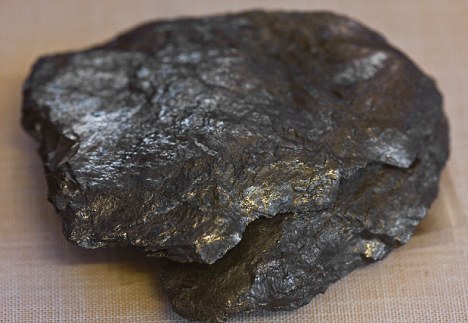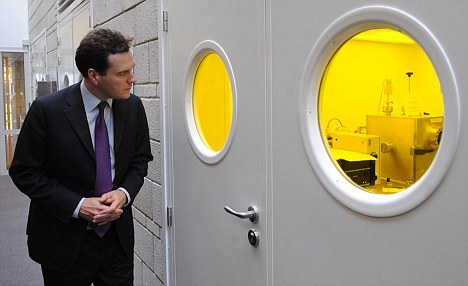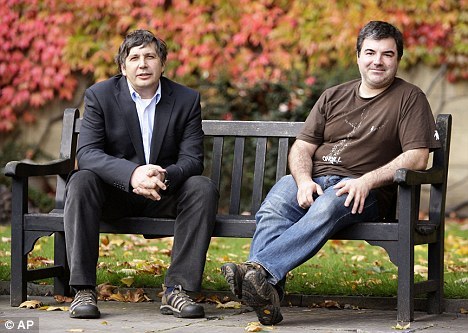UK develops ultra-sturdy material graphene: hard super diamond soft as rubber
 Graphene is a honeycomb structure composed of carbon atoms and is the most important new material developed in the past century.
Graphene is a honeycomb structure composed of carbon atoms and is the most important new material developed in the past century.  Graphene is based on graphite and has a very small thickness. The thickness of 3 million graphene stacked together is only 1 mm.
Graphene is based on graphite and has a very small thickness. The thickness of 3 million graphene stacked together is only 1 mm.  The British Chancellor of the Exchequer George Osborne visited the University of Manchester Laboratory for the study of graphene. He said the government took out £50 million to help develop technology based on this new material.
The British Chancellor of the Exchequer George Osborne visited the University of Manchester Laboratory for the study of graphene. He said the government took out £50 million to help develop technology based on this new material.  In 2004, Professor Andrew Gamm (left) and Professor Konstantin Novosov first isolated graphene. In 2010, they both won the Nobel Prize in Physics.
In 2004, Professor Andrew Gamm (left) and Professor Konstantin Novosov first isolated graphene. In 2010, they both won the Nobel Prize in Physics.  If the development of graphene is successful, the manufacture of iPad tablet telegraph and Kindle e-reader will revolutionize. Graphene is a "super material" that is more rigid than diamond and stretches like rubber. Its electrical and thermal conductivity exceeds that of any copper wire and its weight is almost zero. As this amazing new material is put into use, revolutions will change in every aspect of our lives. Skeptics point out that most new materials, such as carbon fiber, take 20 years to become commercially available after invention, and graphene is no exception. Now, scientists have embarked on the road to great graphene revolution, but this road is also full of uncertainty. High performance and low cost Some researchers say that graphene is the most important new material developed after the first synthetic plastics more than 100 years ago. If this new material with superior performance is put into use, it will no longer be a dream to develop a mobile phone that can be bent and placed behind the ear. The thickness of the high-definition TV will be as thick as that of the wallpaper, and the electronic newspaper will become Bending allows the reader to place it in a small space. Graphene can revolutionize the pharmaceutical industry and replace silicon as a raw material for making computer chips. Seven years ago, the British discovered this magical material. In 2010, two scientists at the University of Manchester won the Nobel Prize in Physics for their achievements in graphene research. This week, the British Chancellor of the Exchequer George Osborne promised to spend 50 million pounds (about 77.78 million US dollars) to develop technology based on this ultra-strong material. In economics, the most exciting feature of graphene is the lower cost. Often, scientists are struggling with the cost of developing a new material. Graphene is produced by chemically treating graphite. Graphite is the raw material for "lead" in pencils and is very low in cost. Every few months, researchers develop new ways to produce graphene on a large scale, further reducing costs. Some experts say that the production cost of graphene can be reduced to less than 4 pounds per pound (about 6 dollars per 453 grams). Can graphene be a new material for the 21st century? The chemical structure of graphene with many characteristics is very simple, and the simplicity is incredible. A piece of graphene is a layer of carbon atoms that are tightly bound together to form a honeycomb pattern. Graphene is the thinnest material ever developed. The thickness of 3 million pieces of graphene stacked together is only 1 mm. In addition, it is also the most sturdy material known to man, with a strength of 200 times that of a diamond and a hardness several times that of a diamond. One of the thinnest materials in history, graphene, can withstand the weight of an elephant. The calculations show that an elephant needs to stand at the end of the pencil to pierce the graphene sheet by weight. In addition to its high strength, graphene also has amazing softness and can stretch 20% without damage. In addition, this material is much more conductive than copper (usually used to produce wires) and is the most thermally conductive material on the planet. Graphene is made of graphite, a gray mineral with very high reserves, mainly produced in Chile, India and Canada. The pencil lead is made up of millions of layers of graphene. These layers are loosely bonded together, which is why graphene will fall off when the pencil is drawn across the paper. In 2004, Prof. Konstantin-Novoshawov and Professor Andrew Gammer first isolated graphene. They used a tape to strip a thin layer of graphite and then placed it on a silicon wafer and observed it with a microscope for confirmation. Professor Novo Sharov was born in Russia and is now 37 years old. He believes that graphene can revolutionize a range of fields from electronics to computers. He said: "I don't think the potential of graphene is exaggerated. With a simple structure - probably the thinnest substance in the world - and a lot of unique properties, this new material has attracted a lot of people's attention. Graphene owns Hundreds of unique features are superior to other materials. Because it is only as thick as one atom, this material is extremely transparent. There are not many transparent materials with conductive properties.†The discovery of graphene, the focus of materials science, has sensational material science. Then it became the focus of research. In 2010, there were 3,000 research papers on graphene properties and 400 patent applications. The electronics industry believes that graphene will revolutionize the manufacture of electronic products, including the iPhone and Kindle. Modern touch screens use indium tin oxide, a transparent material that is electrically conductive and expensive to manufacture. In addition, screens made with this material can easily break or break. Replacing indium tin oxide with a graphene-based compound allows for the manufacture of soft, thin paper-like computers and television screens. Korean researchers used graphene to make a 25-inch (63.5 cm) flexible touch screen. If graphene is used as a raw material, the face of electronic newspapers will change radically. Let's imagine, tap the button in the corner of the e-newsletter, update the content or move to the next page. After reading it, fold it up and open it the next day to continue browsing the content you care about. Other researchers have turned their attention to the medical use of graphene. In addition, this new material can also be used to replace carbon fiber hulls and bicycle bodies. The strength of tires made of graphene also exceeds that of ordinary tires. Some researchers say that graphene can even replace silicon for the manufacture of computer chips. In the future, a graphene credit card can store the same amount of information as today's computers. Novosov said: "We are developing many of the characteristics of this new material. So many people have studied a material that has never been seen before. You may want to combine it with plastic. Graphene is a kind of The versatile material is equivalent to the sum of all plastics. This is a surprising material, and its potential has not been exaggerated, which is why so many researchers have studied this material.†The British government is too “trick†"The graphene can be compared with phenolic resins, the first plastic synthesized by scientists, which was invented in 1907," said Su-Mosman, director of the Materials Science Institute at the London Science Museum. Phenolic resins are highly resistant to heat and chemicals and are an excellent electrical insulating material for the production of power plugs, radios, cameras and telephones. She said: "Will the era of phenolic resin be a thing of the past and replaced by graphene? Historical experience tells us that our country is very good at invention, but it is not good at putting the invention into practice." Some great inventions in British history are ultimately not Appropriate commercial development, for the benefit of ordinary people, such as polyethylene and carbon fiber, if you do not let the graphene step these inventions, the British government needs to invest a lot of money for research and development. This is why the government's contribution to help R&D has won applause at the Conservative Party meeting. But compared with the US and Asia's investment in graphene research and development, the Minister of Finance promised 50 million pounds. In order to develop graphene-based technology, the Korean government invested 195 million pounds (about 300 million US dollars), the European Commission is expected to invest 1 billion euros (about 1.3 billion US dollars) in the next 10 years to develop graphene technology. Despite the passion for the development of graphene technology, many researchers doubt whether this new material can achieve such high expectations. Before graphene, scientists have also developed amazing new materials, but the final application is pitiful. In 1985, scientists developed a new carbon material fullerene, which was hailed as a revolutionary new material at the time. Despite a lot of publicity, this material has not been put into practical use. The use of graphene also faces a series of problems. This material is extremely conductive and can be used to make transistors - responsible for controlling the current, and the ability to block the flow of current - etc., but this use of graphene has proven to be challenging. At the beginning of 2011, IBM admitted that it was "hard to imagine" replacing silicon with graphene for the production of computer chips. Skeptics point out that most new materials, such as carbon fiber, take 20 years to become commercially available after they are invented. Now, scientists have embarked on the road to great graphene revolution, but this road is also full of uncertainty.
If the development of graphene is successful, the manufacture of iPad tablet telegraph and Kindle e-reader will revolutionize. Graphene is a "super material" that is more rigid than diamond and stretches like rubber. Its electrical and thermal conductivity exceeds that of any copper wire and its weight is almost zero. As this amazing new material is put into use, revolutions will change in every aspect of our lives. Skeptics point out that most new materials, such as carbon fiber, take 20 years to become commercially available after invention, and graphene is no exception. Now, scientists have embarked on the road to great graphene revolution, but this road is also full of uncertainty. High performance and low cost Some researchers say that graphene is the most important new material developed after the first synthetic plastics more than 100 years ago. If this new material with superior performance is put into use, it will no longer be a dream to develop a mobile phone that can be bent and placed behind the ear. The thickness of the high-definition TV will be as thick as that of the wallpaper, and the electronic newspaper will become Bending allows the reader to place it in a small space. Graphene can revolutionize the pharmaceutical industry and replace silicon as a raw material for making computer chips. Seven years ago, the British discovered this magical material. In 2010, two scientists at the University of Manchester won the Nobel Prize in Physics for their achievements in graphene research. This week, the British Chancellor of the Exchequer George Osborne promised to spend 50 million pounds (about 77.78 million US dollars) to develop technology based on this ultra-strong material. In economics, the most exciting feature of graphene is the lower cost. Often, scientists are struggling with the cost of developing a new material. Graphene is produced by chemically treating graphite. Graphite is the raw material for "lead" in pencils and is very low in cost. Every few months, researchers develop new ways to produce graphene on a large scale, further reducing costs. Some experts say that the production cost of graphene can be reduced to less than 4 pounds per pound (about 6 dollars per 453 grams). Can graphene be a new material for the 21st century? The chemical structure of graphene with many characteristics is very simple, and the simplicity is incredible. A piece of graphene is a layer of carbon atoms that are tightly bound together to form a honeycomb pattern. Graphene is the thinnest material ever developed. The thickness of 3 million pieces of graphene stacked together is only 1 mm. In addition, it is also the most sturdy material known to man, with a strength of 200 times that of a diamond and a hardness several times that of a diamond. One of the thinnest materials in history, graphene, can withstand the weight of an elephant. The calculations show that an elephant needs to stand at the end of the pencil to pierce the graphene sheet by weight. In addition to its high strength, graphene also has amazing softness and can stretch 20% without damage. In addition, this material is much more conductive than copper (usually used to produce wires) and is the most thermally conductive material on the planet. Graphene is made of graphite, a gray mineral with very high reserves, mainly produced in Chile, India and Canada. The pencil lead is made up of millions of layers of graphene. These layers are loosely bonded together, which is why graphene will fall off when the pencil is drawn across the paper. In 2004, Prof. Konstantin-Novoshawov and Professor Andrew Gammer first isolated graphene. They used a tape to strip a thin layer of graphite and then placed it on a silicon wafer and observed it with a microscope for confirmation. Professor Novo Sharov was born in Russia and is now 37 years old. He believes that graphene can revolutionize a range of fields from electronics to computers. He said: "I don't think the potential of graphene is exaggerated. With a simple structure - probably the thinnest substance in the world - and a lot of unique properties, this new material has attracted a lot of people's attention. Graphene owns Hundreds of unique features are superior to other materials. Because it is only as thick as one atom, this material is extremely transparent. There are not many transparent materials with conductive properties.†The discovery of graphene, the focus of materials science, has sensational material science. Then it became the focus of research. In 2010, there were 3,000 research papers on graphene properties and 400 patent applications. The electronics industry believes that graphene will revolutionize the manufacture of electronic products, including the iPhone and Kindle. Modern touch screens use indium tin oxide, a transparent material that is electrically conductive and expensive to manufacture. In addition, screens made with this material can easily break or break. Replacing indium tin oxide with a graphene-based compound allows for the manufacture of soft, thin paper-like computers and television screens. Korean researchers used graphene to make a 25-inch (63.5 cm) flexible touch screen. If graphene is used as a raw material, the face of electronic newspapers will change radically. Let's imagine, tap the button in the corner of the e-newsletter, update the content or move to the next page. After reading it, fold it up and open it the next day to continue browsing the content you care about. Other researchers have turned their attention to the medical use of graphene. In addition, this new material can also be used to replace carbon fiber hulls and bicycle bodies. The strength of tires made of graphene also exceeds that of ordinary tires. Some researchers say that graphene can even replace silicon for the manufacture of computer chips. In the future, a graphene credit card can store the same amount of information as today's computers. Novosov said: "We are developing many of the characteristics of this new material. So many people have studied a material that has never been seen before. You may want to combine it with plastic. Graphene is a kind of The versatile material is equivalent to the sum of all plastics. This is a surprising material, and its potential has not been exaggerated, which is why so many researchers have studied this material.†The British government is too “trick†"The graphene can be compared with phenolic resins, the first plastic synthesized by scientists, which was invented in 1907," said Su-Mosman, director of the Materials Science Institute at the London Science Museum. Phenolic resins are highly resistant to heat and chemicals and are an excellent electrical insulating material for the production of power plugs, radios, cameras and telephones. She said: "Will the era of phenolic resin be a thing of the past and replaced by graphene? Historical experience tells us that our country is very good at invention, but it is not good at putting the invention into practice." Some great inventions in British history are ultimately not Appropriate commercial development, for the benefit of ordinary people, such as polyethylene and carbon fiber, if you do not let the graphene step these inventions, the British government needs to invest a lot of money for research and development. This is why the government's contribution to help R&D has won applause at the Conservative Party meeting. But compared with the US and Asia's investment in graphene research and development, the Minister of Finance promised 50 million pounds. In order to develop graphene-based technology, the Korean government invested 195 million pounds (about 300 million US dollars), the European Commission is expected to invest 1 billion euros (about 1.3 billion US dollars) in the next 10 years to develop graphene technology. Despite the passion for the development of graphene technology, many researchers doubt whether this new material can achieve such high expectations. Before graphene, scientists have also developed amazing new materials, but the final application is pitiful. In 1985, scientists developed a new carbon material fullerene, which was hailed as a revolutionary new material at the time. Despite a lot of publicity, this material has not been put into practical use. The use of graphene also faces a series of problems. This material is extremely conductive and can be used to make transistors - responsible for controlling the current, and the ability to block the flow of current - etc., but this use of graphene has proven to be challenging. At the beginning of 2011, IBM admitted that it was "hard to imagine" replacing silicon with graphene for the production of computer chips. Skeptics point out that most new materials, such as carbon fiber, take 20 years to become commercially available after they are invented. Now, scientists have embarked on the road to great graphene revolution, but this road is also full of uncertainty.A hose is a flexible hollow tube designed to carry fluids from one location to another. Hoses are also sometimes called pipes (the word pipe usually refers to a rigid tube, whereas a hose is usually a flexible one), or more generally tubing. The shape of a hose is usually cylindrical (having a circular cross section).Hose design is based on a combination of application and performance. Common factors are size, pressure rating, weight, length, straight hose or coilhose, and chemical compatibility.Our hose has two materials, one is rubber hose, the other is stainless steel iron pipe, the length can be customized according to customer requirements.
Gas Hose,Gas Rubber Pipe,High Pressure Pvc Pipe,Natural Lpg Gas Plastic Pipe
Ningbo SaiOu Cookware Co., Ltd. , https://www.nbsaioucookware.com